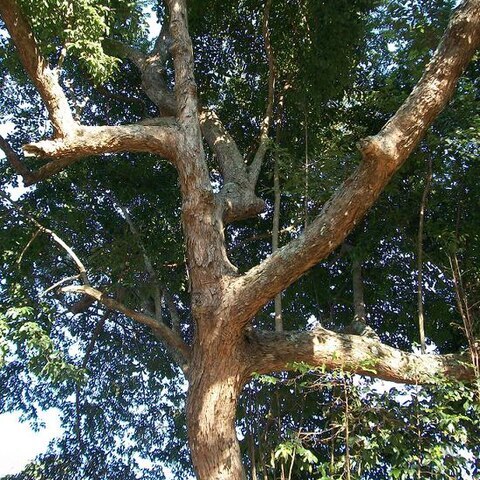Perennial tree or shrub, 1-30 m high; many-stemmed, densely branched; flattened crown; twigs lenticellate. Leaves chartaceous, obovate to elliptic-lanceolate, base rounded to cuneate, apex obtuse or rounded to acutely acuminate; glabrous above and beneath; petioles terete, grooved or winged. Stipules linear-lanceolate or oblong, acute or obtuse, entire, membranous, soon falling. Inflorescence: bracts ovate, chaffy, soon falling. Male flowers: pedicels glabrous or sparingly pubescent; sepals unequal, concave, becoming reflexed; disc shallowly 4-lobed; stamens 2-3 mm long. Female flowers: pedicels 2-20 mm long; sepals entire, thick; ovary glabrous or sparingly to evenly puberulous; styles erect, spreading or reflexed. Fruit subglobose to shallowly or deeply (2)3(4)-lobed, smooth or verrucose. Seeds: exotesta fleshy; endotesta planoconvex, smooth.
It can be a shrub but also a large tree. It can be 8 m high or 20 m high. The bark is pale grey and smooth. In large trees with buttresses the bark can be rough. The leaves are oval and 2-8 cm long by 1.3-4 cm wide. They can be larger in large trees. The leaves are bright green. The edges roll under. The flowers are small and greenish-yellow. The sexes are on different trees. Male flowers are many and in the axils of leaves. Female flowers occur in pairs in the axils of leaves. The fruit is a 3 lobed capsule. It is yellow and 10 mm across. They turn blue when ripe. There are 6-8 seeds per fruit. There are several varieties.
Leaf blades 1–11 × 0.5–6 cm, obovate to elliptic-lanceolate, obtuse or rounded to acutely acuminate, rounded to cuneate at the base, chartaceous, glabrous above and beneath or else puberulous at least along the midrib beneath; pale green and dull or dark green and shiny (var. nitida) above, paler beneath; lateral nerves in 5–15 pairs, sometimes with 1–2 interstitials between each pair, scarcely prominent above, somewhat so beneath, tertiary nerves reticulate.
Female flowers: pedicels 2–20 mm long, not or only slightly extending in fruit; sepals ± as in the male flowers, greenish; disk 1.5 mm in diameter, ± entire, thick; ovary 2 mm in diameter, glabrous or sparingly to evenly puberulous; styles 2–4 mm long, stylar column 0–2 mm high, stylar arms 2 mm long, erect, spreading or reflexed.
Semi-deciduous shrub or small tree with spreading crown. Trunk straight, buttressed. Bark brown, rough, flaking irregularly to expose red-brown under bark. Leaves simple, ovate to obovate; bright green, papery. Flowers inconspicuous, yellowish-green. Fruit a three-lobed capsule, yellow.
Male flowers: pedicels 2–7 mm long, glabrous or sparingly pubescent; sepals 1–3 × 1–1.5 mm, unequal, concave, becoming reflexed, pale yellow-green; disk 0.5–2 mm in diameter, shallowly 4-lobed; stamens 2–3 mm long, anthers 0.5–1.5 mm long.
Fruits 5–7 mm long, 1–1.3 cm wide, subglobose to shallowly or deeply (2)3(4)-lobed, smooth or verrucose, often prominently nervose-reticulate, glabrous to sparingly puberulous, golden-brown when ripe.
Seeds 5 × 5 × 2.5 mm; exotesta fleshy and bright glossy metallic-blue or purplish-blue when fresh, drying papery and greyish-white; endotesta plano-convex, smooth.
A many-stemmed, densely branched spreading to somewhat sarmentose deciduous shrub or tree up to 25 m high (rarely more) often with a flattened crown.
Stipules 2–13 mm long, linear-lanceolate or oblong, acute or obtuse, entire, membranous, soon falling.
Petioles 1–9 mm long, terete, grooved or winged, glabrous to densely crisped-puberulous.
Inflorescence bracts 2–3 mm long, ovate, chaffy, brownish or blackish, soon falling.
Bark grey or brownish, flaking in irregular strips.
Bole up to 30 cm d.b.h.
Twigs lenticellate.


